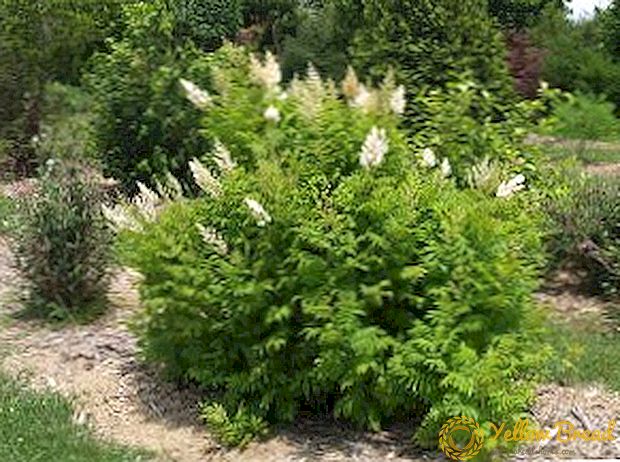 If you want to increase the number of families in your apiary, bee swarm trap - an easy and inexpensive way to do it. You only need a little wood and plywood, four or five frames from the hive and a little time.
If you want to increase the number of families in your apiary, bee swarm trap - an easy and inexpensive way to do it. You only need a little wood and plywood, four or five frames from the hive and a little time.
- What is it for
- Fundamental rules
- How to make a trap
- Terms for use
- Where to place
- Removing traps
What is it for
Beekeeping starts with bees. Every amateur enthusiast in his business wants his bees to be healthy, active and bring in more honey. Instead, in the market we get commercial bees of "mass release" grown in an environment that is not closely resembling natural conditions. The productive uterus is fed with sugar syrup, and when the offspring grows up, it is also stuffed with sugar syrup and chemical preparations. Then to this family they add a new, artificially fertilized bee-woman, pack everything into a box and sell it to you. For a lot of money, by the way.

The phrase of the unforgettable Winnie the Pooh "is the wrong bees that make the wrong honey," well describes the situation.
The alternative is to catch stray swarms, in which the bees are already adapted to the existing conditions. "Choose a model of the hive that is best suited to your area, populate it with local bees, and the results will speak for themselves," the famous French beekeeper Georges de Lavens wrote in the book Full Course of Apiculture back in 1892.
To acquire a local breed, it does not even need to buy. Fishing for swarms in the forest is a great way to get these bees.
Fundamental rules
A good bee trap should have the following qualities:
- Sufficient volume. The volume from 40 to 60 liters is most to the liking of scouts who are choosing a future home for the family. Store extensions for beehives, which are also used as traps, are small, a little more than 20 liters, but if you combine two extensions, you can get quite a suitable container.
- Letke. The letka should have an area of 10-12 square centimeters, imitating the entrance to the hollow of a tree inhabited by wild bees. The easiest way is to make a slot 1.5 cm high and 8 cm long — birds do not penetrate through it.
- Ease. 5-6 kilograms - no more! The trap must be such that it can be held in one hand, climbing a tree or standing on a stepladder.
- Durability and strength. The longer the trap serves, the more “catchable” it is. The more swarms you caught, the more pheromones remain in the box, attracting new families.
- Water resistant. Not a drop of rain should get inside. Bees will never choose a damp place for living.
- Simplicity in construction. The design should be understandable to the ordinary person who knows how to hammer nails and has several power tools.
- The ease of transferring the swarm to a permanent hive. Therefore, a standard frame should be trapped.
- The trap should like a scout. Before bringing the swarm to the chosen place, the scout measures the size of the future house, crawling along its walls and flying inside. The trap, completely filled with frames, will seem to her too small, so more than half of the internal space should be left free.

Important points:
- "Bait". If the trap is new, it needs to be treated with propolis. Heat a piece of propolis in your hands and, when it becomes soft and sticky, rub it on the inner walls.Pheromone baits for bees work well too - you can buy them at specialized sites.
- Dark honeycombs. The smell of wax and old honeycombs attracts a swarm. If you have a frame with old, darkened honeycombs - put at least one such frame into the trap. Even the frames that you would throw out will do. But make sure the frames are from a healthy family, and freeze them 48 hours to kill possible parasites. Although the wax moth never hits the hives with a newly caught swarm - probably because the traps are set in the spring.
- Materials Plywood or hardwood boards are best for making traps. The hollows in which the bees live in nature have uneven walls, so it’s not necessary to do a very smooth inner surface. If you walked on the walls, you would also like to be able to cling to them.
How to make a trap
To build a trap you will need:
- 8 mm plywood or board-ten, better not planed;
- wood glue;
- screws or nails;
- metal mesh with a centimeter cell;
- clippers;
- wallpaper nails or screws with washers;
- several frames, better than the old ones, from the existing hive;
- paint.

How to build:
- Cut out the cover, sides and bottom for your chosen dimensions. For example, the bottom and the lid are 50 × 25 cm, the front and rear walls are 50 × 27.5 cm, and the walls are 27.5 × 22.5 cm.
- Spread the joining edges with wood glue and join the parts together, then fix them with screws.
- Make a pendant for frames from thin rails and glue or attach them to the side walls 2-2.5 cm from the top of the box with screws. On it will lie the projections of the framework.
- To hang it from a tree, attach a 7 × 60 cm plank to the central part of the back wall and cut a round hole about 3 cm in diameter in its upper part. Thus, a trap full of bees will be easier to remove from the tree.
- Jig saw out the notch - a slit 1.5 × 8 cm below and in the center of the front wall. With the help of wallpaper nails or screws with washers on top of the inlet, fix the metal grid. This will allow the bees to get inside, but will not allow the birds and rodents to crawl into the trap.
- The lid is made to rotate - in one of the corners, fasten it with a screw with a washer that will work as an axis.
- Paint the finished product.
Terms for use
The swarming of bees and, accordingly, the catching of swarms begins at the end of spring and goes to the middle of summer (in the middle lane - from May 25 to July 10), although swarms can fly out a little later. Consequently, traps must be installed at the end of May.
There is another small swarming peak in September, but such swarms are usually small, up to 1.5 kilograms. They can be added to already existing families, but it is better to leave them trapped by adding frames. Before the first frosts, they can stock up their own honey, and for the winter, the family with its reserves is transferred to a regular hive.
Where to place
A well-built trap is only part of the story. One of the most important questions is how to install the fabricated structure in order to catch a swarm of bees in it.
Success also depends on where the apiaries are located and, better, the nests of wild bees, and also where, in your opinion, it is better to set traps for them.

By placing traps, you can focus on the advice of experienced beekeepers:
- Perfect height. 4-6 meters from the ground.Bees can choose a place for the hive and below, but they usually look for a place inaccessible to the marauders and away from the damp earth.
- Visibility. If you do not see the trap from 30 meters, the bees will also find it difficult to find it.
- Shadow. Scouts will not lead a swarm into a place that is hot under the sun.
- Light color. For the above reason - protection against overheating, the color of the walls should be light - white, light gray, etc.
- Visible trees. Best of all - standing on the edge of the forest, near the road, at the edge of a clearing in the forest or distinguished by its size.
- Proximity to swarming families. Proximity to the apiary or to the places where wild bees live makes it much easier to catch a swarm. But you shouldn't place traps too close either - they never work on the territory of the apiary or next to it, and already 30-50 meters away from it, they are willingly engaged in swarms.
- Places that bees know. The scouts who are looking for a place where the swarm will lodge are the same workers who previously collected nectar and pollen. Therefore, they first look at familiar places. That is why it is especially suitable for placing traps in a place where there are always a lot of bees - gardens and areas where good wild honey plants bloom.Places where there is little food — for example, pastures and coniferous forests — rarely attract a swarm.
- Water source. Water is one of the most important needs of the family. 100% of the traps in which swarms settle in are at a maximum distance of a couple of hundred meters from a stream or pond.
- Orientation. In some beekeeping allowances it is indicated that the entrance is better to turn to the south, but in practice none of the beekeepers use a compass for this. The direction of the notch has almost no significance, for the bees the other considerations listed above are more important.
- Lucky trees. The tree and the place where you caught the swarm will attract bees in the future - later in the same season, and in the following years. Therefore, it is a good idea to put an empty trap in place of what you just removed.
Removing traps
From time to time, about once a week, check the installed traps. If you notice a large number of insects flying in and out, you can congratulate yourself. Come back before sunset, when all the working bees have returned from the fields, and take your prey.

But before removing the trap, put the ear to its wall and tap it lightly. A loud buzz confirms that there is a swarm inside. If the box is empty or you hear the buzz of only a few insects, it means that the bees that you saw during the day are scouts, and the swarm will arrive tomorrow or the day after. Come back later.
Therefore, if you see that the bees are bustling around the entrance - it does not mean that there is a swarm inside. Scouts, which are usually a few dozen, sometimes hundreds, after finding a suitable place, evaluate it and lead a swarm later - in 2-5 days. Sometimes the swarm does not appear.
Inspection of the trap after dark is the surest way to make sure that a swarm has settled in it. Here are some more signs of this:
- if you see a large mass of bees covering the walls of the box and a tree trunk - the swarm has just arrived and will move inwards within about an hour;
- the scouts move quickly and impetuously, fly in and immediately fly out of the entrance, turn around, and just arrived insects can not immediately find the entrance;
- if the bees carry pollen - a swarm inside.Scouts never collect pollen. Come after a week. If the bees are still a lot - they began to settle down.

In the evening, at dusk or after sunset, climb a tree or climb stairs and use a stapler to close the entrances with a very fine metal mesh. Remove or untie the box and lower to the ground. If the height is small - just hold it in your hand, if the tree is high or the place is uncomfortable - on a rope.
To highlight yourself, use a headlamp with a red light filter. Bees do not see the red light and do not worry, and you work quietly.
In case the apiary is closer than 5 kilometers from the place where the swarm was caught, first you need to take the trap seven kilometers to the other side and leave it open for a week. Otherwise, the bees will not return to the hive, but to the place where they were caught.
If the swarm stayed with you not long enough for the brood to appear, there is a small chance that the bees will gather. To bind a new family to the apiary, you can substitute them with several frames with brood taken from another hive.
That's all you need to know about how to catch a bee swarm and transfer it to your apiary. Difficult at first glance, the task is quite simple. Try it and see for yourself.






